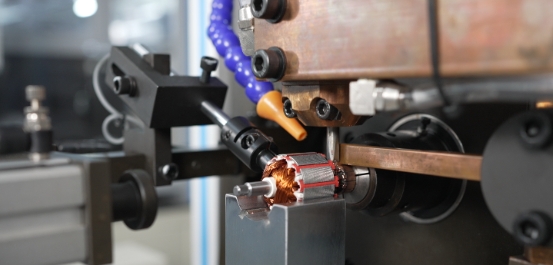How to Troubleshoot and Troubleshoot Motor Motor Rotor (Single Station) Spot Welding Machine?
For fault analysis and troubleshooting of motor rotor spot welder (machine for welding commutator hooks), here are some key steps and methods:
1. Troubleshooting:
lOverheating phenomenon: check whether the insulation resistance between the electrode holder and the body is poor, forming a local short circuit. Check whether the inlet water pressure, water flow rate and water supply temperature are appropriate, and whether the water circuit system is blocked by dirt, resulting in poor cooling to overheat the electrode arm, electrode rod and electrode head.
Welding point indentation is serious and there is extrusion: check whether the current is too large, whether the welding workpiece is uneven, whether the electrode pressure is too large, and whether the electrode head shape and cross-section are appropriate.

2. Troubleshooting:
No output: check whether the base plate (power board) power supply problems, whether there is 300 volts DC output. Check whether the auxiliary power supply is damaged, whether there is a driving pulse, whether there is a failsafe, and whether the internal connecting wires of the welder are detached.
Problems with power supply leads and welding cables: If the power supply leads and welding cables are coiled into a disk shape and the pole is too large, replace the high-power welder or use two in parallel. Reduce the length of the lead wire or increase the wire diameter, release the lead wire, and reconnect the joints.
3, vibration and loud noise is too large:
Check whether the screw and tensioning spring on the moving iron core is loose or off, whether the transmission mechanism of the moving iron core or moving ring is faulty, whether the moving slide is badly worn and the clearance is too large, and whether the coil is short-circuited.
4. The adjusting handle can not be shaken or the moving iron core or moving coil can not be moved:
Check whether the transmission mechanism is too much grease or has rusted, whether the transmission mechanism is worn, whether there are obstacles on the moving slide, whether the lead wire of the welder coil is tethered or squeezed in the coil.
5. Coil insulation resistance is too low:
Check whether the coil is damp, whether the coil is overheated for a long time, insulation aging, and dry it in the drying oven at 100~110°C, or overhaul the coil.
6. The fuse is often blown:
Through the above steps, the motor rotor spot welder can be effective fault analysis and troubleshooting to ensure the normal operation of the equipment and productivity.
※ If the above ways and means still can not solve the equipment failure, please contact Xinhui Electromechanical Equipment Co., Ltd. technical specialists through the page chat tool to seek help.







